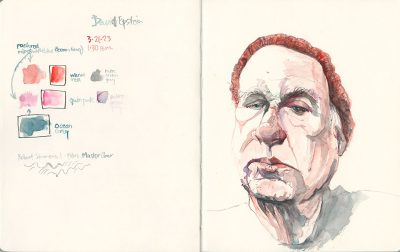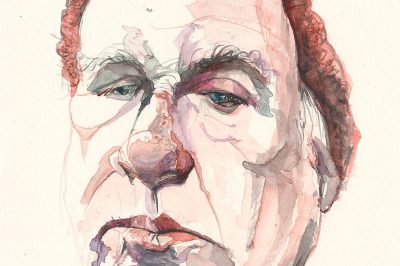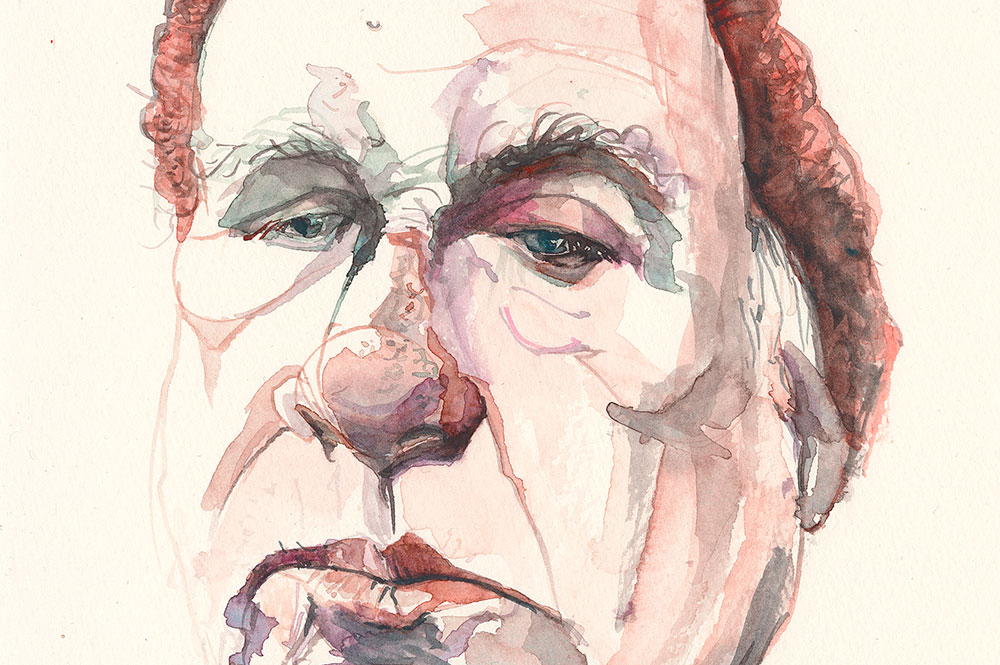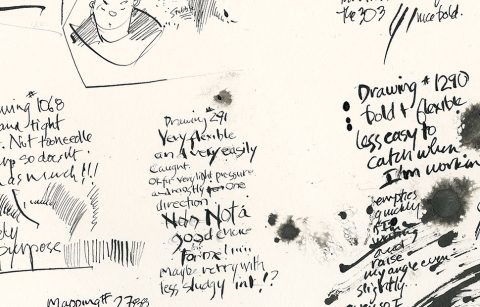
I admit it. I love experimenting.
I had a new paint from Schmincke—Ocean Grey. I had a wonderful face reference from Sktchy. And I had a LINER BRUSH!
Note: There are liner brushes and rigger brushes. They are and aren’t interchangeable. Both are long-tipped. If you want a long brush to apply paint it might not matter to you. But liner brushes are made for making lines, signing your signature, painting decorative sworls and such—think really intricate paint lines on cars! Rigger brushes are typically used for fine lines in paintings like tree branches and the rigging of ships. You can certainly look deeper into the nomenclature and history and find which are used for which. To me the important thing is knowing what you want in a thin brush.
Brush tip length will give you the ability to pull a long straight line that curves when you want it to curve. There are painters detailing cars with liner brushes doing symmetrical designs that are so masterful your eyes will actually tear up. They use soft, long bristled brushes which hold a lot of paint. (I’m not sure but I think they use an enamel paint—it has to be something that holds up to the weather when you put it on a car.)
The same idea applies in watercolor. You often want to paint smooth curves, or other types of lines.
What I Look for in a Liner/Rigger
I think of liner and rigger brushes as pretty much the same thing, by which I mean, I’m looking for a long thin brush tip and I’ll use whichever will give me what I want to get down on the paper.
That means I’m looking for a long brush tip to get even lines. A brush with some sort of belly, or with hairs/fibers, that can carry a good paint load. Something with spring and push back because it’s the type of brush that works best for my method of painting. And of course something with a short, comfortable handle.
Liner brushes give the most amazing lines of paint.

Liner brushes are the reason I started working with a Pentel Brush Pen (I wanted the continuous feed the pen allowed).
Liner brushes are especially great for direct brush painting—you don’t do any pre-sketching or drawing of lines, you just jump in with the paint.
To test this new ocean grey paint I put three paints on my palette, a warm red, quin. pink, and ocean grey. I started mixing and drawing.
All the paint application you see in today’s image is placed with the liner brush.
Detail showing lines and the side-brush application of paint.
This means that sometimes I put the liner brush flat to the paper and pulled it sideways creating a broad passage of paint; sometimes I overloaded it and put a large wash spot down and pushed it around.
The latter isn’t a great way to use this brush as it wears the tip and body out fairly quickly (I am hard on my brushes).
But if you are careful and place the brush on the paper so you don’t push the point into the paper, but instead put the side down, and then keep the brush fairly flat to the surface instead of bending the tip at its halfway point (which will distress and even break the bristles over time), you can get a nice wide stroke of color down and still have a happy brush.
I mention that last action because it’s the way many watercolorists who come to my classes use their round brushes, but because the brush tip is shorter, they can’t bend the bristles at the halfway point before they reach the belly and let the wash out, so they can have a useful brush for sometime. (If they watch this action and eliminate the excessive bend when they place their brush on the page their brushes will last longer. Ditto for avoiding going in tip first—go in instead on the side of your tip, whenever possible, which is actually most of the time if you’re thinking about it.)
I used an old Robert Simmons Fabric Magic Liner. I think they were made for fabric painting. I haven’t seen them in stores in years. I just happened to have this one leftover from a project. It is of course my favorite liner and it’s pretty worn now, as I started doing a lot of testing with it in this latest bout of experimentation.
But Robert Simmons also makes a Sapphire line which has a Liner, and a Google search shows some others that might be good possibilities. I will discuss some other brushes I found in upcoming posts.
Direct Brush Painting
You’ve seen me do direct brush painting a lot. I particularly enjoy doing it on gessoed watercolor paper—because the gesso makes the watercolor so easy to lift and push about. (Sort of like drawing with charcoal and pushing the dust around.)
Direct brush painting is something you can experiment with on your own. Picking a subject with dramatic lighting is always useful because the tendency is to look for lines and you actually want to look for SHAPES—shadows.
I recommend that the first few times you try it you do it monochromatically, using only an ink wash. (Dilute ink into 4 to 5 values that you apply as you work.)
By all means, if you’re using a thin brush like the one I used for today’s image—draw some lines. It’s simply too fun not too. But don’t lose sight of the goal, which is to get the subject down in washes without any pre-drawing. Drawing police aren’t going to be knocking at your door, but if you keep your mind on the shapes, you’ll still get to draw some lines, and in the meantime you’ll be stretching the visual way in which you process the gestalt of the image you’re trying to get on paper. That’s always a great thing. Otherwise, why not just start with a pencil or pen right?
Have some fun direct brush painting today. I’ll be back with more on liner brushes.























Love the neutralized palette of realistic flesh tone colours here, and the chiselled look you got with the liner brush👍👍. BUT, I though you were dead set against using pre-mixed “convenience “ blacks or greys (preferring to mix your own neutrals instead???) .
First you do realize that I’m a die-hard fan of Sean Connery and we all know to “Never say Never.”
So I can’t say I’m dead set against anything because one never knows what will come in the future (who knew I would be living as I’m living right now!? I’ve had to make all sorts of adaptations!)
But you are correct if you believe I am not, in general, at all interested in using black pigments, straight or mixed with other pigments, or in using pre-mixed grays. Pre-mixed colors aren’t as interesting to me and they remove the control of certain fine-tuning options you have if you mix them yourself. And I find that grays and blacks added to mixes tend to dull things a lot. (I’m just so happy today to learn one of my students is giving up Payne’s Gray, for now, always for now. And looking at other more colorful ways to get the same results.)
When I bought the ocean gray I was at the store, having received a mailer, and I wanted the tube because I wanted to try a new blue, and I don’t believe I even looked at the pigment label BECAUSE I was in a hurry to get out of the store. (As you know I’m still having to wear a mask all the time in public and the mask actually causes other breathing issues.) So I dashed in and out.
One could say it was an impulse buy.
But it’s still interesting to use and of course I had to test it and am still testing it a little bit every day or so seeing if my eyes are seeing it favorably or not.
Would I buy another tube of it. NO! I would simply get the three pigments it contains and mix it as I needed it on the fly, with more of the blue or green as needed, and less of the black.
But the other reality is I probably wouldn’t even do that because I don’t like how the black dulls things down in general, and yet in this mix is difficult to get a strong contrast from—not impossible, just less quick than I care for.
I am still testing liner brushes so I’m continuing to use these 3 colors (the blue and two reds) because I do like that type of consistency. Then I know the flow and the volume of paint a brush I’m testing holds is going to be easier to monitor and compare, because my eye won’t be fooled by a color that’s more saturated, etc. And some pigments simply flow differently.
So in a way I’m a prisoner of that impulse buy, because it happened on a day I decided to pick up and start testing liners—though are they really that random or do they have something very significant that connects them? Maybe that’s something I’ll find out in the process of testing the liners.
But I am 99.9 percent sure I won’t be adding this black-containing paint on my full-time palette. I think for landscape artists who are already using convenience paints in their work for their own reasons this might be a useful quick sky color on certain days? But bottom line, some colors just appeal to our eye in the abstract and then we have to work out how to make them work in our artistic vision.
I happened to pick a subject that lends itself to the high-key value of the pink with the white paper, and I agree the line of the liner brush looks fun here with the subject’s wrinkles. But as you’ll see when others in the testing get posted, my mind and hand and eye haven’t settled on a happy, constant approach with this color and I’m still trying to find out what it is that draws me.
Again, I’m not advocating this paint at all. It’s just what is being tested because it’s what I started with on this date—or is it?
And by the way, I feel the same about Perylene Green. I love it in a lot of mixes and in different things I’ve done, but the results always leave me a little cold.
Right now the main goal is to simply keep painting with whatever paints I can find that have not been moved to storage or lost! I’ll work out what it all means later.